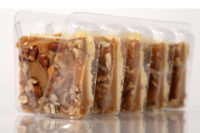Flexible plastic pouches and bags are playing an increasingly important role in the strong global growth of confectionery packaging, which is forecast by Zion Market Research to reach $6.3 billion by 2025.
According to Zion, the plastics segment is expected to dominate the confectionery packaging market over the next seven years, primarily because these materials help extend product shelf life — which is especially important for candy sold via ecommerce sites. Another factor driving growth of flexible packaging, particularly standup pouches, is consumer demand for grab-and-go candy and snacks, often packaged in convenient, individual servings.
The growing popularity of flexible packaging, in turn, is prompting plastic film processors, converters and packaging manufacturers to seek new ways to optimize production efficiency, control costs and simplify supply chain management. One way to achieve all these objectives is to use the right plastic additives.
Improving Film Processing with Additive Chemistry
Most polymers require an improvement or modification to their formulation with one or more additives to ensure the best processing performance — and polyethylene (PE) blown film used in packaging applications is no exception.
The global market for PE blown films is predicted to grow by 3.9 percent through 2023, according to Allied Market Research. It is a popular choice for flexible food packaging due to its cost-effectiveness, toughness, flexibility, ability to be heat sealed, moisture barrier properties and transparency. Additionally, under U.S. Food and Drug Administration (FDA) regulations, some untreated high- and low-density PE resins are considered safe for food contact, as certified by their vendors.
Effectively processing PE film typically requires two closely related capabilities:
- Slip reduces the coefficient of friction (COF) by minimizing surface friction, resistance and tackiness, helping the film layers slide smoothly over each other and processing equipment. This property makes it easier to process and handle the film.
- Anti-blocking helps prevent adjacent film layers from sticking to each other due to electrostatic charge or Van der Waals forces (attractive forces between polymer chains). Incorporating anti-blocking properties creates a micro-rough surface that reduces adhesion between adjacent film layers and helps prevent damage.
Used together, advanced slip and anti-blocking additives can deliver these properties to help ensure high throughput with minimal interruptions or waste and consistent quality of the PE film.
Since these complementary additives must work together synergistically for desired results, many film processors and converters are forced to spend time and effort attempting to determine, through trial and error, the correct ratio of slip and anti-blocking agents — and to ensure their chemistries are compatible. Further, working with individual additives usually means dealing with two different suppliers, handling and storing stocks of two different materials and using separate additive feeders for the production line. All this duplication can raise costs, increase complexity and introduce the potential for error.
Combining Slip and Anti-blocking Functionality
A simpler, more elegant and practical solution is using a single masterbatch that delivers the right balance of compatible slip and anti-blocking capabilities. A new dual-function, silicone-based masterbatch for PE blown film, DOW CORNING AMB-12235 Masterbatch from DuPont, was developed for this approach. It creates synergistic effects through the precise combination and amount of each active ingredient. For additional simplification and cost-effectiveness, this product can replace processing additives typically used with PE film.
The new masterbatch’s slip capabilities help lower the COF of blown film to reduce its resistance to sliding over itself or manufacturing rollers. This improved slip performance remains stable over time and under high temperatures. Silicone chemistry also helps prevent migration to the film surface that can affect downstream operations, such as printing and metallization. Additionally, the material will not affect key mechanical properties of the film, including tensile elongation/strain and tear strength.
By creating a micro-rough surface, the silicone-based masterbatch’s anti-blocking properties minimize points of contact between film layers to avoid adhesion and tearing and facilitate easy, clean unrolling of the film.
This multi-functional product spares processors from the burden of finding compatible additives and calculating ratios. It can simplify production by cutting the number of additive feeders, freeing up space and reducing infrastructure complexity. Beyond the production line, customers can save storage space, facilitate supply chain management and streamline material handling.
Conclusion
Today’s consumer buying habits, from online purchasing to on-the-go snacking, are helping to increase the popularity of flexible confectionery packaging. Many of these package designs use durable, protective and cost-effective PE blown film. To respond to growing market demand for PE film, converters and packaging manufacturers are looking for ways to improve processing speed while maintaining or improving quality and cost control. Consolidation of critical slip and anti-blocking capabilities into a single, optimized masterbatch can help them achieve these goals.




